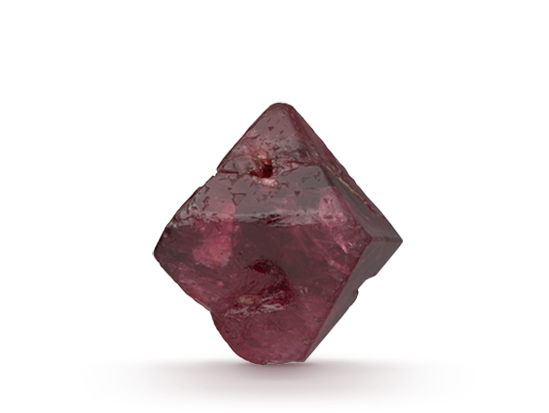OVERVIEW
Until recently, spinel was an underappreciated gem with little consumer recognition. Increasing demand for ruby alternatives rekindled appreciation for spinel’s rich red color and history. In ancient times, southeast Asia’s mines yielded exceptional large spinel crystals, which became the treasured property of kings and emperors, often passing through many hands as spoils of war.
Spinel, like garnet and diamond, is singly refractive, with the same physical properties in all crystal directions. It belongs to the cubic crystal system, and its characteristic crystal shape is an octahedron, which looks like two back-to-back pyramids. Well-formed spinel crystals are fairly common in nature.
Spinel can also form flattened crystals that look radically different from octahedral crystals. The flattened shape occurs when the pyramids that form an octahedron rotate against each other during growth. Scientists describe this as a “twinned crystal.” Large gems cut from good-color twinned crystals are typically shallow, and should be judged on their overall beauty rather than on proportions alone.
- Mineral: spinel
- Chemistry: MgAl2O4
- Color: red, orange, pink, purple, blue, black
- Refractive index: 1.718
- Birefringence: none
- Specific gravity: 3.60
- Mohs Hardness: 8
WHERE IS IT FOUND ?
Today, spinel is found in several locations. Major sources include Tajikistan, Myanmar, Sri Lanka, Vietnam, Tanzania and Pakistan. Some sources are known for producing spinel of arresting color, like hot pink and red spinel from Myanmar.
Sri Lanka is a veritable Treasure Island of different gem species and varieties, including sapphire, ruby and garnet. Spinel is mined across the southern half of the country. Colors found there include blue, pink and purple. The lush rolling hills of the Central Highlands and river gravels in the Ratnapura District have been rich sources for centuries.
Myanmar’s Mogok Stone Tract is another prolific source, one where ruby, sapphire and other gem minerals are found along with this and the other August birthstone, peridot. Gems unearthed there are so naturally lustrous that locals call them “spirit polished.”
CARE & CLEANING
Spinel is 8 on the Mohs scale of hardness, so it is typically a durable gem for rings and other jewelry. Ultrasonic and steam cleaners can be used; however, the presence of fractures could pose a problem. Warm soapy water is always a safe alternative.
Spinel is stable when exposed to light and chemicals. High heat can cause some colors of this August birthstone to fade.
BIRTHSTONE
Alexandrite is a birthstone for June, along with pearl and moonstone. Alexandrite is also the gem for the 55th wedding anniversary.
HISTORY
Spinel is a good candidate for the title of “History’s Most Underappreciated Gem.” Some ancient mines that supplied gems for royal courts from Rome to China produced spinel, but it was usually confused with better-known stones like ruby and sapphire.
In ancient times, the mines of central and southeast Asia yielded exceptionally large spinel crystals. These fine stones became known as Balas rubies, and some of them were the treasured property of kings and emperors, often passing through many hands as spoils of war. As a result, some of the world’s most illustrious “rubies” are actually spinel.
One of the most famous examples is the so-called “Black Prince’s ruby.” This historic crimson-red gem is set in England’s Imperial State Crown and displayed in the Tower of London. Smoothly polished and roughly octagonal in shape, it was probably mined in the mountains of Afghanistan. It first appeared in the historical records of fourteenth-century Spain, and was owned by a succession of Moorish and Spanish Kings before Edward, Prince of Wales—the “Black Prince”— received the stone in 1367 as payment for a battle victory.
Since then, many other English monarchs—including Henry VIII—have cherished the gem. It’s outlasted them all, surviving fires, attempted theft, and World War II bombing raids, to become—with the Koh-i-Noor diamond—one of the centerpieces of England’s Crown Jewels.
Another large spinel in the Crown Jewels, the “Timur ruby,” weighs over 350 carats. It, too, has a checkered history. Several Persian inscriptions carved into the gem testify to its age.
Modern technology hasn’t helped spinel’s confused identity as far as the general public is concerned. This is due largely to the widespread use of synthetic spinel as an imitation for many other gems. Most customers aren’t even aware that there’s a natural version of the stone.
Source of Content : www.gia.edu


